Our Verdict
The Garmin Forerunner 955 boasts all of Garmin’s best tracking and training analysis features and while it’s still expensive at $500 in the US and £480 in the UK, it is significantly cheaper than the Garmin Fenix 7 and Epix 2, the only other watches that can match its performance.
For
- Excellent GPS accuracy
- New training readiness feature is useful
- Maps and music
- Cheaper than Fenix and Epix
Against
- Iffy HR accuracy
- Battery life not exceptional
You can trust Coach
The Garmin Forerunner 945 has long been one of the best running watches you can buy, offering most of the features of the Garmin Fenix line in a lighter, cheaper watch. The new Garmin Forerunner 955 brings the “9X5” line up to date with features first seen on the Garmin Fenix 7 and Epix 2, as well as introducing some entirely new features.
Headline updates include a solar version of the watch that lasts longer in sunny conditions, multi-band GPS for more accurate distance tracking, and an all-new training readiness feature that will give advice on how hard you should train.
I’ve been testing the Garmin Forerunner 955 Solar for four weeks and it’s a superb watch that is considerably cheaper than the Fenix 7 and Epix 2 while having all of Garmin’s best features.
Garmin Forerunner 955: Price And Availability
The Garmin Forerunner 955 is available now from Garmin US and Garmin UK, with the standard model $499.99 in the US and £479.99 in the UK. That’s actually a drop in price for the current standard model – the Forerunner 945 originally had an RRP of $599.99/£519.99 (it has now been permanently reduced to $399.99/£499.99).
The 955 Solar costs $599.99/£549.99.
Recent updates
December 1, 2023: There are now regular sales and deals featuring the Garmin Forerunner 955. In our extensive coverage of the best Black Friday Garmin deals in 2023 the best price we tracked was $399.99.
Design And Hardware Specs
The Forerunner 955 has a different design from the 945: it’s marginally thicker at 14.4mm compared with 13.7mm and has a slightly smaller case at 46.5mm vs 46.7mm. The screen is bigger on the 955, which has a 33mm 260x260 pixels display compared with 30.4mm 240x240 pixels on the 945. The Forerunner 955 also has a touchscreen, like the Garmin Epix 2 and Fenix 7.
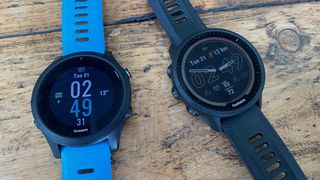
One appealing aspect of the Forerunner 955 versus the Fenix 7 and Epix 2 is that its plastic case is much lighter: the 955 weighs 53g compared with 70-80g for the Fenix and Epix, though of course the more expensive watches do use more aesthetically appealing and tougher materials.
As with the Fenix 7 and Garmin Instinct 2, there is now a solar version of the Forerunner 955. The Forerunner 955 has all the same features as the 955 Solar, bar the solar panels on the watch face.
The Forerunner 955 is laden with sensors. There’s a heart rate sensor, pulse oximeter, altimeter, barometer and compass, and you can connect external sensors via ANT+ or Bluetooth. The watch is waterproof to 5 ATM and offers multi-GNSS tracking that uses GPS, Galileo and GLONASS satellite systems simultaneously, plus a multi-band, multi-GNSS mode to further increase the accuracy of its outdoor activity tracking.
GPS And Heart Rate Accuracy
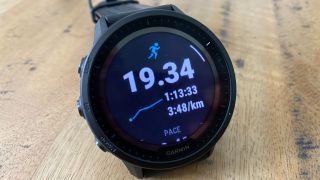
I have been wearing the Epix 2 to track all my runs since December 2021 and have been very impressed by Garmin’s multi-band GPS tracking on that watch – and the Forerunner 955 delivers similarly high levels of accuracy.
I’ve had no major GPS aberrations in over 400km of running, and it consistently logs me on the correct side of the road and tracks about-turns accurately. It outperforms most other watches, including the Forerunner 945, in tricky GPS conditions such as when under tree cover or among tall buildings.
I nearly always chose the multi-band tracking to get this level of accuracy, though the multi-GNSS setting is almost as good and isn’t as battery-intensive. It’s a handy option to have when you’re in good GPS conditions and aren’t too fussed about top-notch accuracy, such as on easy runs, reserving the multi-band setting for important workouts and races.
Unfortunately the 955’s heart rate accuracy was less impressive. On several runs it read lower or higher than a reading from a chest strap for long periods, and it would miss or lag behind spikes in heart rate during interval runs or when running up hills. Given that accurate heart rate data is crucial for the training analysis on the watch, I’d highly recommend pairing it with a chest strap or even an armband tracker to ensure you’re getting good data. Our recommendations of the best heart rate monitors will help you find something suitable.
Training Readiness And HRV Status
Training readiness is an entirely new feature for Garmin that’s being introduced on the Forerunner 955 (it will be added to the Epix 2 and Fenix 7 in due course through a firmware update). This is a colour-coded score based on several factors like your recent training load, sleep, recovery time and heart rate variability (HRV) status, and offers guidance on how hard you should train that day.
Readiness ratings based on your HRV are appearing more frequently but with varying degrees of success, depending on the accuracy of the data fed in. The readiness score on the Oura Ring is useful, for example, while I found Fitbit’s daily readiness score pretty much pointless.

Garmin’s readiness score, fortunately, falls into the useful camp. It’s right there on your wrist when you wake up in the new morning report feature, and it’s easy to see the factors that feed into it via a widget on the watch, so you can see that while your training load is spot-on, your recent sleep history is sub-par, for example. Having all the underlying factors laid out encourages you to think about aspects of your life and how it can impact on your sports performance.
Over a month of use, the training readiness score has tracked closely with how I was actually feeling on a given day and never hit a bum note. Using data from the recorded training load makes it a more informed score than the readiness rating from my Oura Ring.
It’s also a nice touch that the readiness score isn’t shown in your morning report on days that you’ve scheduled a race in the new race planner widget – no-one wants to see a poor readiness score on race day, though you can still seek it out if confident you’ll find a good score to boost your spirits.
One factor in the readiness score is your HRV status. It takes the watch three weeks to set a baseline for this, and it’s measured during the night. Once your baseline is set your HRV is rated against it each day, showing whether you are in your normal range or outside of it.
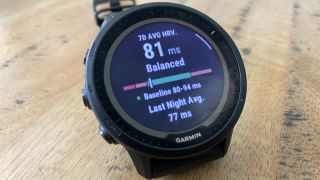
The accuracy of HRV tracking by the watch was generally good when compared with my Oura ring. While the Oura consistently logged a higher max HRV each night – the 955 always missed one or two spikes looking at the graphs – the average reading was almost always similar, and the 955 picked up the same ups and downs in my HRV rating each night.
Overall, the new readiness and HRV features on the 955 are a success, even if they seem to come at a cost to battery life. These are useful measurements that can help you plan out your training, and I really like how the training readiness feature makes it clear what factors feed into your score, since this could help amateur athletes recognise what may be holding them back when their actual training load is well-balanced.
Sports Tracking

The new training analysis features and improved GPS come on top of Garmin’s excellent all-round sports tracking. There are modes for every sport I can think of, and the big three of running, cycling and swimming are particularly comprehensive in the stats they track.
You can now also view running power live on the watch without the need for a separate app, although you still need to pair the 955 to a Garmin Running Dynamics Pod or HRM-Pro. The Forerunner 955 also has the real-time stamina measurement introduced on the Epix 2 and Fenix 7.
Other new features on the watch include a morning report, which delivers your sleep rating, weather forecast and a suggested workout for the day at a glance. There’s also a race day widget, which will take a date you set in the Garmin Connect app, count down to the big day and provide information like the weather forecast for the event, as well as adjusting your training suggestions around the race.

These training suggestions are generally pretty good, in that if you followed them each day I have little doubt you’d get fitter, and they’d help you prepare for a race. However, they can be quite basic, and experienced runners and triathletes will get more from planning their own training or using a coach.
Battery Life
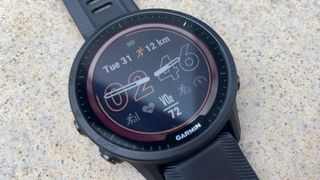
The Forerunner 955 offers a slightly longer battery life than the Forerunner 945 in smartwatch mode or when using the standard GPS-only tracking mode. However, opting for multi-band tracking will bring the battery life down, and I found that the 955 Solar would last around eight days on a charge when running almost every day with multi-band mode on. Given that I had the Solar watch on in largely sunny (for the UK) conditions, you might only get seven days from the standard 955 with heavy use.
| Header Cell - Column 0 | Forerunner 945 | Forerunner 955 | Forerunner 955 Solar |
|---|---|---|---|
| Smartwatch mode | 14 days | 15 days | Up to 20 days |
| GPS-only | 36 hours | 42 hours | Up to 49 hours |
| GPS-only with music | 10 hours | 10.5 hours | 10.5 hours |
| Multi-band GPS | N/A | 20 hours | Up to 22 hours |
| Multi-band GPS with music | N/A | 8.5 hours | 8.5 hours |
Seven days is a little more than I get from the Epix 2 with its AMOLED screen, which tends to last five or six days on a charge, though well short of what you will get from the Fenix 7, Garmin Enduro or Coros Vertix 2, which can all last weeks without charging. It will be interesting to see what the battery life on the Epix 2 and Fenix 7 is like once the training readiness and HRV status features arrive on those watches, because I get the impression that these increase the drain on the battery overnight.
Maps And Navigation
Like the Epix 2 and Fenix 7, the Forerunner 955 has full-colour maps. You can set up courses in Garmin Connect or third-party running route apps like Strava and Komoot, and get turn-by-turn directions from the watch, or create new routes on the watch itself, either before you run or halfway through it when you realise you’re entirely lost.
The navigation on Garmin’s top watches is head and shoulders above what you get from other companies, with better maps, clearer routing and clever features like ClimbPro. The latter analyses all the big climbs and descents in your route and highlights that information when you reach that point of the route so you can pace your efforts accordingly.
Smart Features
The Forerunner 955 offers music storage including the ability to link up a Spotify Premium account for offline playback, and other useful smart features include weather forecasts, notifications, NFC payments and access to the Connect IQ app store. There aren’t many apps – it’s nothing like the App Store or Google Play – but there are a couple of handy ones like a parkrun barcode widget, and you can get loads of different watch faces too if Garmin’s default range doesn’t satisfy your customisation needs.
Activity And Sleep Tracking
As with sports tracking, the Forerunner 955 is a great activity tracker, recording all the usual stats like steps and active calories. There’s also Garmin’s body battery score, which rates your energy levels out of 100 based on things like your recent training, stress, sleep and HRV.
Your step goal can also be set to adjust in line with your activity levels, which is how my daily goal has climbed to over 20,000 steps during marathon training. An intimidating target and one to ignore on rest days.
I have long been unimpressed with the sleep tracking available on Garmin watches, since I’ve found it tended to overestimate time asleep by logging periods where I was still watching TV or reading as light sleep. This is still something the 955 does, unfortunately, but the sleep score is still fairly useful in showing trends in my rest each night, rising and falling in line with how good my sleep actually was.
The somewhat iffy sleep tracking hasn’t negatively affected my experience of the readiness score. A future update is also intended to improve Garmin’s sleep tracking by better recognising when you’re restless during the night.
You will still get better sleep tracking from the Oura ring, or Fitbit, Polar and Huawei watches, but if you’re less interested in the sleep stats themselves and more in their impact on your ability to train, the 955 gives more useful insights.
Is The Garmin Forerunner 955 Worth It?
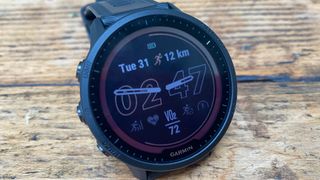
The updates to the Forerunner 955 bring it into line with the Fenix 7 and Epix 2 and introduce a couple of useful new features. The solar panels on the Solar will also be a worthwhile upgrade for some people, though for my money the cheaper Forerunner 955 for $500/£480 is the better deal since the battery life improvements aren’t substantial enough.
That $500/£480 price is also very attractive when you consider that it’s only the sapphire models of the Fenix 7 and Epix 2 that have multi-band tracking, and they cost from $899.99/£779.99 for the Fenix 7 and $999.99/£899.99 for the Epix 2, which has a brighter AMOLED screen. With the Forerunner 955 you’re getting all of Garmin’s best features in a cheaper watch with a lighter plastic case that still looks great, even if not quite as handsome as the metal Fenix and Epix watches.
Outside of Garmin’s other top watches there is nothing that can compete with the Forerunner 955’s features. It’s more expensive than Polar’s top watch – the Vantage V2 – but offers more accurate tracking and a better all-round experience.
But the question is less “Can anything match those features?” and more “Do you need them?” You can get significantly cheaper watches like the Garmin Forerunner 255 or Coros Pace 2 that offer excellent multisport tracking, useful training insights and, in the case of the 255, music and breadcrumb navigation. They don’t have all the bells and whistles of the 955, but still cover everything most of us really need and more.

Nick Harris-Fry is a journalist who has been covering health and fitness since 2015. Nick is an avid runner, covering 70-110km a week, which gives him ample opportunity to test a wide range of running shoes and running gear. He is also the chief tester for fitness trackers and running watches, treadmills and exercise bikes, and workout headphones.

